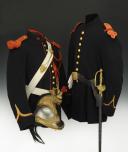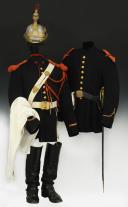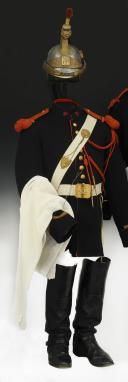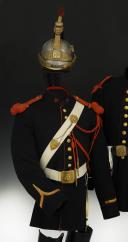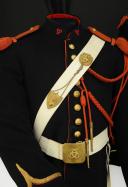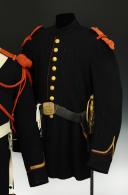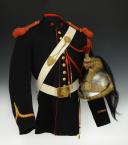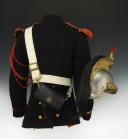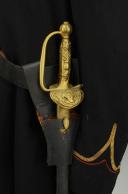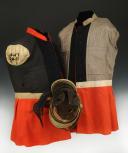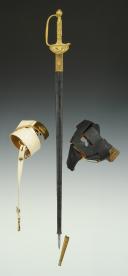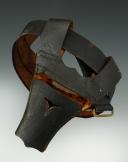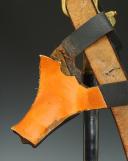
LOT DE DEUX UNIFORMES DE GRANDE TENUE ET DE PETITE TENUE DE LA COMPAGNIE ÉQUESTRE DE POLICE DE LA VILLE DE BORDEAUX, Troisième République.
Sold out
LOT OF TWO DRESS UNIFORMS AND UNDRESS UNIFORMS FROM THE EQUESTRIAN POLICE COMPANY OF THE CITY OF BORDEAUX, Third Republic.
DRESS UNIFORM
Helmet based on the model of cuirassier helmets, 1872 model, composed of a bowl, a visor, and a neck guard in steel. All fittings in brass. Visor and neck guard edged with a brass strip folded over the outer edge. Neck guard lined with black waxed leather. Front band with the coat of arms of the city of Bordeaux in the center framed by laurel branches. Brass crest composed of two fins struck with a series of diminishing gadroons towards the back and a mask at the lower part and a Medusa head at the upper part, fixed to the bowl by means of four brass screws. Aigrette holder consisting of a brass socket, an olive, and a scarlet plume. Black horsehair mane, approximately 53 cm in length, with a braid in the center. Square-section tubular plume holder slightly tapering downwards. Chinstraps made of leather chinstraps covered with festooned scales and rosettes attached to the bowl by means of a lock. Helmet marked "10399 B". Inner leather lining with seven lobes.
Dark blue almost black dress uniform made of wool, closing straight at the front with nine gilded brass buttons stamped with a flaming bomb, scarlet piping. Collar adorned with scarlet embroidered collar patches of the city of Bordeaux cipher, lined in scarlet wool. Cuffs in dark blue wool forming a point at the front, scarlet piping, topped with a gilt lizard-woven golden cord epaulette, width 1.3 cm. At the back, two vertical false pockets with two pointed scarlet piped cuffs, each adorned with three uniform buttons. Shoulder loops in dark blue wool covered with orange lace. Pair of clover-shaped epaulettes in dark orange woven lace, marked "35?3" (one unreadable digit). Orange dark aiguillettes in woven lace with two brass ferrets decorated with flaming bombs.
Pair of white cotton drill gauntlet gloves.
Buff leather giberne with a 5.4 cm wide white buff banderole, double stitched. Brass buckles and fittings. Decorated at the front with an embossed lion's muzzle in brass and a badge stamped with a grenade with three pin chains. Black varnished leather giberne box, H 10 cm, width 18 cm, thickness 6 cm. Buff leather waistbelt with saber hanging loop, width 5 cm, double stitched, saber suspension strap in white buff leather, width 2 cm. Rectangular plaque with cut corners, H 6.5 cm, width 7.5 cm, decorated in the center with the Bordeaux cipher.
Cavalry breeches in white cotton drill closing with a bone button with a four-button fly.
Pair of black patent leather knee-high riding boots with a rigid upper part. One of the boots is marked "AU SABOT ROUGE 30 RUE DE FLANDRE PARIS" with the number "5." Total height 52 cm. Studded heel, outer foot length 31.5 cm. Steel spurs, complete with ankle straps.
France. Third Republic.
Helmet in good condition, oxidation on the steel parts to be cleaned, wear on one of the fins, poor condition of the inner lining.
Uniform in very good condition.
Gloves in new condition.
Giberne and waistbelt in very good condition.
Breeches in poor condition with tears and damage.
Pair of boots in very good condition.
UNDRESS UNIFORM
Undress uniform made of dark blue almost black wool, closing straight at the front with nine gilded brass buttons stamped with a flaming bomb, scarlet piping. Cuffs in dark blue wool forming a point at the front, scarlet piping, topped with a 7mm wide golden lizard-woven epaulette grade cord. At the back, two vertical false pockets with two pointed scarlet piped cuffs, each adorned with three uniform buttons. Shoulder loops in dark blue wool covered with orange lace. Pair of clover-shaped epaulettes in orange woven lace.
Black varnished leather waistbelt, width 4.5 cm, with a scabbard carrying loop. Brass buckles. Square belt buckle, 6 cm x 6 cm, decorated with the Bordeaux cipher.
Sword on the model for the non-commissioned officers of the Second Empire Paris Guard: monobloc cast brass hilt, keyboard decorated with the Bordeaux cipher surrounded by two palms, solid guard branch, grooved pommel, relief-molded handle with a flaming bomb and laurel branch. Straight double-grooved blade, length 77.2 cm, marked "96" on the blade. Natural leather cravat. Black varnished leather scabbard with two brass trimmings.
France. Third Republic.
Uniform in very good condition.
Waistbelt in very good condition but scabbard carrying loop in poor condition (torn).
Sword in good condition, hilt in very good condition, blade with slight surface oxidation, scabbard in good condition but leather broken above the mount.
COAT OF ARMS AND CIPHERS OF THE CITY OF BORDEAUX:
The coat of arms of Bordeaux is a symbolic representation recalling the history of the city.
The first known coat of arms of Bordeaux dates back to the medieval era of Richard the Lionheart (Richard I of England). It notably features the three lions of the Plantagenet family, which eventually became associated with the coat of arms of England.
"Gules; with the Big Bell open, pierced and masoned of sable and surmounted by a golden leopard; Azure sea wavy of sable and argent, charged with a crescent also argent; of azure chief, sown with France."
- The "Big Bell": representing the towers of the old city hall of which today only the Big Bell remains.
- The "leopard": in heraldry, the lion and the leopard designate the same animal, the lion, but with a different head position. The lion with a profile head is blazoned "lion"; with a frontal head, it's blazoned as "leopard." Here, it's the lion of the Plantagenets, who became kings of England. During the English period (1154-1453), the coat of arms of Bordeaux featured three lions, which can still be seen today in the English coat of arms. With the end of the English possessions of the king of England following the Battle of Castillon in 1453, only one lion remains.
- The "azure sea wavy of sable and argent": a stylized representation of the Garonne River.
- The "crescent": alluding to the semi-circular shape of the port of Bordeaux, which is why it's called the "Port of the Moon" since the Middle Ages.
- "Azure chief sown with France": at the top of the coat of arms are represented the arms of the King of France. This part was added after the English period, replacing the two English lions.
Logo, "small coat of arms," and "cipher" of Bordeaux.
The Bordeaux "cipher," also known as the "small coat of arms," is a stylized representation used as a modernized signature, sometimes used in place of the coat of arms. It is formed by three intertwined crescent moons. It was not found before the mid-17th century. Initially, it was featured on the back and covers of the winning books awarded by the College of Guyenne, and in the 18th century, adorned the pediment of the Saint-Projet fountain (1715) and later the Grave fountain (1788). It is now the symbol used for the city logo.
Regarding the origin and meaning of this symbol, there are multiple versions. For some, the three crescents represent the three curves of the Garonne in the urban area or the combination of the Garonne, the Dordogne, and the Gironde rivers. For others, they may come from the arms of Diane de Poitiers or from King of France Henri II.
More likely, these crescents originate from the single one featured on the city arms, representing the Port of the Moon. As for the number three, according to former Bordeaux mayor Adrien Bayssellance, it is more likely a coincidence. The single crescent alone created a too meager decorative motif, and three have been intertwined to enhance the balance aesthetically.
PROVENANCE:
This set comes from the same policeman and has never been separated since the Third Republic.
Note:
This uniform model is rare and directly inspired by that of the Republican Guard of Paris.
The helmet is also known with the Bordeaux cipher instead of the city coat of arms. Other cities had similar helmets, such as Marseille, Lyon, and Nîmes.
HISTORY:
It is rare to find archives on this type of unit; however, there is a very interesting study on the equestrian police of Lyon.
Mounted Police
Equestrian Units in Community Policing
The Equestrian Police Company of Lyon - A Small Republican Guard
http://www.slhp-raa.fr
In Lyon, the prefecture was inaugurated on August 20, 1890, by Prefect Jules Cambon. This occasion marked the consolidation of the central police services, gradually transferring them from the Presqu'île to the left bank of the Rhône. To this end, the prefect decided to build a police barracks on Molière Street, 20 meters from the prefecture. It was designated as the "Central Barracks of Foot and Mounted Peacekeepers with a post and telegraph office, outbuildings, and a police station." Its architecture resembled that of a barracks with a central building and two wings opening onto a courtyard, a parade ground; a mini cavalry quarter with a riding school, stables, saddle room, hayloft, etc. It was long referred to as the "municipal guard" barracks. The enclosure wall remained largely unchanged over the decades. A guardhouse turret was built, "recessed into the enclosure wall, pierced with small loopholes fitted with shutters to protect the sentry from drafts." For the external decoration, the prefect received eight "hors-service" artillery shells from the place commander. This building retained this general architecture until its destruction starting in 2008. An underground passage between the barracks and the prefecture was dug. It was intended for cavalry passage. A slight problem arose, the vaulted height initially planned had to be revised by the architect to allow the passageway of fully harnessed mounts with their riders. The height was raised to 2.40 m. The cavalry was used as a force for breaking up crowds. This explains the importance given to the construction of this passage to safely and discreetly transport reinforcements within the prefectural compound. It also provided the prefect with an escape route during a siege. Its secretive existence fueled press fantasies for a century. Mounted peacekeepers participated in prefecture guard duties; inside were foot peacekeeper posts and security police, troops with infantrymen and dragoons, and firefighter squads. Small stables in the Pierre Corneille building were reserved for police and military mounts, plus a garage for prefectural vehicles.
This central barracks housed, in addition to the mounted unit, a company of peacekeepers, a police station and guardhouse, cells and violins, a police station, and quarters for officers, single peacekeepers, and those with families, housed in apartments or dormitories.
The mounted brigade, established in 1882, consisted of 30 men and 32 horses. Commanded on January 10, 1890, by a second lieutenant, a sergeant-major, four sergeants including a chief, and 24 guards. They wore cavalry ranks. The most appropriate term seems to be that of a company and not a squadron, as it was organized into three brigades and, in 1916, commanded by Lieutenant Cottaz; accompanied by a veterinarian. The riders received higher pay than the foot guards. Like in the military, they formed a kind of aristocracy and displayed a superiority conferred by their stature and uniform. A mindset that would later be found among police bikers. At that time, almost all uniformed officers were from the military, and the mounted riders were from the cavalry or the peasant world.
In our research, we came across the files of some of these "centaurs": "Decroze, a handsome man, but light-hearted, too fond of the ladies, very good rider"; in case of punishment, they could be put on foot. Their riding aptitude was noted; one of them had "lack of balance on horseback". Jules, Simon Groc, transferred from the 2nd Company to the 1st Company on September 11, 1903. He received remuneration on December 31, 1906, amounting to 25 francs for training a new horse. On October 17, 1912, Peacekeeper Officer Bacci reported the fall of the peacekeeper and the horse: "On the 17th, around 2:30 in the afternoon, the troop was returning in columns of two from a maneuver at the Grand Camp, at the end of the dike, near the railway bridge, where there is earthmoving work, the horse slipped on its forelegs and fell on its knees pulling its rider, who suffered a muscle tear in the left leg leading to 10 days of service exemption. This peacekeeper was destined to join this unit. He had been the orderly of Squadron Commander Matuszynski of the 10th Cuirassiers. He was noted as "Excellent rider, handsome guy, of a very serious character, intelligent, devoted, and honest. Former farmer." He received a testimonial of satisfaction.
They wore prestigious uniforms. In full dress, these riders wore a dark blue uniform, borrowed from the dragoons and gendarmes, with apricot (dawn?) and scarlet trimmings (only known color engraving), aiguillettes with a clover or epaulettes, white breeches, knee-high boots, gauntlet gloves, a helmet with a lion on the mask; Lyon's arms on the collar, buttons, and belt buckle, and military braid. They were armed with an 8mm regulation revolver and a sword (ceremonies, honors, escorts, law enforcement). They did not wear a cartridge box (unlike the dragoons). It is possible they had carbines as well. In service dress, they wore the foot police uniform, dolman, with red distinctive markings, boots, and cap-kepi.
In addition to prefecture guard duty, honor escorts, ceremonies, and parades, they provided daily liaisons and couriers and took part in law enforcement operations that did not require military intervention. During President Sadi Carnot's visit to Lyon on June 25, 1894, the procession was open by the "mounted municipal guards." The escort was provided by cuirassiers. The assailant was subdued by Gendarme Piétri, Security Officer Colombani, and Peacekeeper Brun. An engraving from that time shows a mounted peacekeeper in the foreground.
The horses received basic military training.
The police cavalry of Lyon would fall victim to World War I and bicycles. An important cycling company was formed in 1913. In 1916, the saddlery was converted into medical offices for the police, and in 1923, a "bicycle garage" was constructed.
Regarding the (municipal) mounted police of the city of Toulouse, we have little information, except for dates when it existed: a public auction notice for the sale of a retired mare on February 19, 189645, and another for the auction on February 22, 1894, for the supply "for one year, of hay, straw, and oats necessary for the feed of the municipal police horses." The municipal police mounted barracks were located on Vidale Street46. This unit must have also disappeared in 1914. However, there is evidence of a bicycle brigade as early as 1904.
The prefecture was previously located at the Hôtel de Ville de Lyon
According to the public-private partnership (PPP) principle
At the price of 629,750 F repayable in 11 installments (PPP). Delivery scheduled for the end of June 1891; inspection of the works by the chief architect on October 12, 1891.
In 1913, an operation for "whitewashing the facades and repair of the Molière barracks, Dunoir and Desaix barracks," included flower beds at the entrance.
Two rooms, one for the day (on the courtyard with weapons rack, bench, and dormitory table, jug, and broom) and the other for the night (with fixed camp beds for four men; adjoining rooms for the mounted guard; pieces adjacent to the foot peacekeepers' stables.
DRESS UNIFORM
Helmet based on the model of cuirassier helmets, 1872 model, composed of a bowl, a visor, and a neck guard in steel. All fittings in brass. Visor and neck guard edged with a brass strip folded over the outer edge. Neck guard lined with black waxed leather. Front band with the coat of arms of the city of Bordeaux in the center framed by laurel branches. Brass crest composed of two fins struck with a series of diminishing gadroons towards the back and a mask at the lower part and a Medusa head at the upper part, fixed to the bowl by means of four brass screws. Aigrette holder consisting of a brass socket, an olive, and a scarlet plume. Black horsehair mane, approximately 53 cm in length, with a braid in the center. Square-section tubular plume holder slightly tapering downwards. Chinstraps made of leather chinstraps covered with festooned scales and rosettes attached to the bowl by means of a lock. Helmet marked "10399 B". Inner leather lining with seven lobes.
Dark blue almost black dress uniform made of wool, closing straight at the front with nine gilded brass buttons stamped with a flaming bomb, scarlet piping. Collar adorned with scarlet embroidered collar patches of the city of Bordeaux cipher, lined in scarlet wool. Cuffs in dark blue wool forming a point at the front, scarlet piping, topped with a gilt lizard-woven golden cord epaulette, width 1.3 cm. At the back, two vertical false pockets with two pointed scarlet piped cuffs, each adorned with three uniform buttons. Shoulder loops in dark blue wool covered with orange lace. Pair of clover-shaped epaulettes in dark orange woven lace, marked "35?3" (one unreadable digit). Orange dark aiguillettes in woven lace with two brass ferrets decorated with flaming bombs.
Pair of white cotton drill gauntlet gloves.
Buff leather giberne with a 5.4 cm wide white buff banderole, double stitched. Brass buckles and fittings. Decorated at the front with an embossed lion's muzzle in brass and a badge stamped with a grenade with three pin chains. Black varnished leather giberne box, H 10 cm, width 18 cm, thickness 6 cm. Buff leather waistbelt with saber hanging loop, width 5 cm, double stitched, saber suspension strap in white buff leather, width 2 cm. Rectangular plaque with cut corners, H 6.5 cm, width 7.5 cm, decorated in the center with the Bordeaux cipher.
Cavalry breeches in white cotton drill closing with a bone button with a four-button fly.
Pair of black patent leather knee-high riding boots with a rigid upper part. One of the boots is marked "AU SABOT ROUGE 30 RUE DE FLANDRE PARIS" with the number "5." Total height 52 cm. Studded heel, outer foot length 31.5 cm. Steel spurs, complete with ankle straps.
France. Third Republic.
Helmet in good condition, oxidation on the steel parts to be cleaned, wear on one of the fins, poor condition of the inner lining.
Uniform in very good condition.
Gloves in new condition.
Giberne and waistbelt in very good condition.
Breeches in poor condition with tears and damage.
Pair of boots in very good condition.
UNDRESS UNIFORM
Undress uniform made of dark blue almost black wool, closing straight at the front with nine gilded brass buttons stamped with a flaming bomb, scarlet piping. Cuffs in dark blue wool forming a point at the front, scarlet piping, topped with a 7mm wide golden lizard-woven epaulette grade cord. At the back, two vertical false pockets with two pointed scarlet piped cuffs, each adorned with three uniform buttons. Shoulder loops in dark blue wool covered with orange lace. Pair of clover-shaped epaulettes in orange woven lace.
Black varnished leather waistbelt, width 4.5 cm, with a scabbard carrying loop. Brass buckles. Square belt buckle, 6 cm x 6 cm, decorated with the Bordeaux cipher.
Sword on the model for the non-commissioned officers of the Second Empire Paris Guard: monobloc cast brass hilt, keyboard decorated with the Bordeaux cipher surrounded by two palms, solid guard branch, grooved pommel, relief-molded handle with a flaming bomb and laurel branch. Straight double-grooved blade, length 77.2 cm, marked "96" on the blade. Natural leather cravat. Black varnished leather scabbard with two brass trimmings.
France. Third Republic.
Uniform in very good condition.
Waistbelt in very good condition but scabbard carrying loop in poor condition (torn).
Sword in good condition, hilt in very good condition, blade with slight surface oxidation, scabbard in good condition but leather broken above the mount.
COAT OF ARMS AND CIPHERS OF THE CITY OF BORDEAUX:
The coat of arms of Bordeaux is a symbolic representation recalling the history of the city.
The first known coat of arms of Bordeaux dates back to the medieval era of Richard the Lionheart (Richard I of England). It notably features the three lions of the Plantagenet family, which eventually became associated with the coat of arms of England.
"Gules; with the Big Bell open, pierced and masoned of sable and surmounted by a golden leopard; Azure sea wavy of sable and argent, charged with a crescent also argent; of azure chief, sown with France."
- The "Big Bell": representing the towers of the old city hall of which today only the Big Bell remains.
- The "leopard": in heraldry, the lion and the leopard designate the same animal, the lion, but with a different head position. The lion with a profile head is blazoned "lion"; with a frontal head, it's blazoned as "leopard." Here, it's the lion of the Plantagenets, who became kings of England. During the English period (1154-1453), the coat of arms of Bordeaux featured three lions, which can still be seen today in the English coat of arms. With the end of the English possessions of the king of England following the Battle of Castillon in 1453, only one lion remains.
- The "azure sea wavy of sable and argent": a stylized representation of the Garonne River.
- The "crescent": alluding to the semi-circular shape of the port of Bordeaux, which is why it's called the "Port of the Moon" since the Middle Ages.
- "Azure chief sown with France": at the top of the coat of arms are represented the arms of the King of France. This part was added after the English period, replacing the two English lions.
Logo, "small coat of arms," and "cipher" of Bordeaux.
The Bordeaux "cipher," also known as the "small coat of arms," is a stylized representation used as a modernized signature, sometimes used in place of the coat of arms. It is formed by three intertwined crescent moons. It was not found before the mid-17th century. Initially, it was featured on the back and covers of the winning books awarded by the College of Guyenne, and in the 18th century, adorned the pediment of the Saint-Projet fountain (1715) and later the Grave fountain (1788). It is now the symbol used for the city logo.
Regarding the origin and meaning of this symbol, there are multiple versions. For some, the three crescents represent the three curves of the Garonne in the urban area or the combination of the Garonne, the Dordogne, and the Gironde rivers. For others, they may come from the arms of Diane de Poitiers or from King of France Henri II.
More likely, these crescents originate from the single one featured on the city arms, representing the Port of the Moon. As for the number three, according to former Bordeaux mayor Adrien Bayssellance, it is more likely a coincidence. The single crescent alone created a too meager decorative motif, and three have been intertwined to enhance the balance aesthetically.
PROVENANCE:
This set comes from the same policeman and has never been separated since the Third Republic.
Note:
This uniform model is rare and directly inspired by that of the Republican Guard of Paris.
The helmet is also known with the Bordeaux cipher instead of the city coat of arms. Other cities had similar helmets, such as Marseille, Lyon, and Nîmes.
HISTORY:
It is rare to find archives on this type of unit; however, there is a very interesting study on the equestrian police of Lyon.
Mounted Police
Equestrian Units in Community Policing
The Equestrian Police Company of Lyon - A Small Republican Guard
http://www.slhp-raa.fr
In Lyon, the prefecture was inaugurated on August 20, 1890, by Prefect Jules Cambon. This occasion marked the consolidation of the central police services, gradually transferring them from the Presqu'île to the left bank of the Rhône. To this end, the prefect decided to build a police barracks on Molière Street, 20 meters from the prefecture. It was designated as the "Central Barracks of Foot and Mounted Peacekeepers with a post and telegraph office, outbuildings, and a police station." Its architecture resembled that of a barracks with a central building and two wings opening onto a courtyard, a parade ground; a mini cavalry quarter with a riding school, stables, saddle room, hayloft, etc. It was long referred to as the "municipal guard" barracks. The enclosure wall remained largely unchanged over the decades. A guardhouse turret was built, "recessed into the enclosure wall, pierced with small loopholes fitted with shutters to protect the sentry from drafts." For the external decoration, the prefect received eight "hors-service" artillery shells from the place commander. This building retained this general architecture until its destruction starting in 2008. An underground passage between the barracks and the prefecture was dug. It was intended for cavalry passage. A slight problem arose, the vaulted height initially planned had to be revised by the architect to allow the passageway of fully harnessed mounts with their riders. The height was raised to 2.40 m. The cavalry was used as a force for breaking up crowds. This explains the importance given to the construction of this passage to safely and discreetly transport reinforcements within the prefectural compound. It also provided the prefect with an escape route during a siege. Its secretive existence fueled press fantasies for a century. Mounted peacekeepers participated in prefecture guard duties; inside were foot peacekeeper posts and security police, troops with infantrymen and dragoons, and firefighter squads. Small stables in the Pierre Corneille building were reserved for police and military mounts, plus a garage for prefectural vehicles.
This central barracks housed, in addition to the mounted unit, a company of peacekeepers, a police station and guardhouse, cells and violins, a police station, and quarters for officers, single peacekeepers, and those with families, housed in apartments or dormitories.
The mounted brigade, established in 1882, consisted of 30 men and 32 horses. Commanded on January 10, 1890, by a second lieutenant, a sergeant-major, four sergeants including a chief, and 24 guards. They wore cavalry ranks. The most appropriate term seems to be that of a company and not a squadron, as it was organized into three brigades and, in 1916, commanded by Lieutenant Cottaz; accompanied by a veterinarian. The riders received higher pay than the foot guards. Like in the military, they formed a kind of aristocracy and displayed a superiority conferred by their stature and uniform. A mindset that would later be found among police bikers. At that time, almost all uniformed officers were from the military, and the mounted riders were from the cavalry or the peasant world.
In our research, we came across the files of some of these "centaurs": "Decroze, a handsome man, but light-hearted, too fond of the ladies, very good rider"; in case of punishment, they could be put on foot. Their riding aptitude was noted; one of them had "lack of balance on horseback". Jules, Simon Groc, transferred from the 2nd Company to the 1st Company on September 11, 1903. He received remuneration on December 31, 1906, amounting to 25 francs for training a new horse. On October 17, 1912, Peacekeeper Officer Bacci reported the fall of the peacekeeper and the horse: "On the 17th, around 2:30 in the afternoon, the troop was returning in columns of two from a maneuver at the Grand Camp, at the end of the dike, near the railway bridge, where there is earthmoving work, the horse slipped on its forelegs and fell on its knees pulling its rider, who suffered a muscle tear in the left leg leading to 10 days of service exemption. This peacekeeper was destined to join this unit. He had been the orderly of Squadron Commander Matuszynski of the 10th Cuirassiers. He was noted as "Excellent rider, handsome guy, of a very serious character, intelligent, devoted, and honest. Former farmer." He received a testimonial of satisfaction.
They wore prestigious uniforms. In full dress, these riders wore a dark blue uniform, borrowed from the dragoons and gendarmes, with apricot (dawn?) and scarlet trimmings (only known color engraving), aiguillettes with a clover or epaulettes, white breeches, knee-high boots, gauntlet gloves, a helmet with a lion on the mask; Lyon's arms on the collar, buttons, and belt buckle, and military braid. They were armed with an 8mm regulation revolver and a sword (ceremonies, honors, escorts, law enforcement). They did not wear a cartridge box (unlike the dragoons). It is possible they had carbines as well. In service dress, they wore the foot police uniform, dolman, with red distinctive markings, boots, and cap-kepi.
In addition to prefecture guard duty, honor escorts, ceremonies, and parades, they provided daily liaisons and couriers and took part in law enforcement operations that did not require military intervention. During President Sadi Carnot's visit to Lyon on June 25, 1894, the procession was open by the "mounted municipal guards." The escort was provided by cuirassiers. The assailant was subdued by Gendarme Piétri, Security Officer Colombani, and Peacekeeper Brun. An engraving from that time shows a mounted peacekeeper in the foreground.
The horses received basic military training.
The police cavalry of Lyon would fall victim to World War I and bicycles. An important cycling company was formed in 1913. In 1916, the saddlery was converted into medical offices for the police, and in 1923, a "bicycle garage" was constructed.
Regarding the (municipal) mounted police of the city of Toulouse, we have little information, except for dates when it existed: a public auction notice for the sale of a retired mare on February 19, 189645, and another for the auction on February 22, 1894, for the supply "for one year, of hay, straw, and oats necessary for the feed of the municipal police horses." The municipal police mounted barracks were located on Vidale Street46. This unit must have also disappeared in 1914. However, there is evidence of a bicycle brigade as early as 1904.
The prefecture was previously located at the Hôtel de Ville de Lyon
According to the public-private partnership (PPP) principle
At the price of 629,750 F repayable in 11 installments (PPP). Delivery scheduled for the end of June 1891; inspection of the works by the chief architect on October 12, 1891.
In 1913, an operation for "whitewashing the facades and repair of the Molière barracks, Dunoir and Desaix barracks," included flower beds at the entrance.
Two rooms, one for the day (on the courtyard with weapons rack, bench, and dormitory table, jug, and broom) and the other for the night (with fixed camp beds for four men; adjoining rooms for the mounted guard; pieces adjacent to the foot peacekeepers' stables.
Reference :
24946
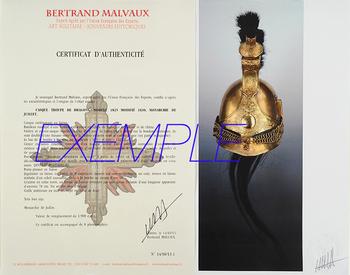
Next update Friday, december 5 at 13:30 PM
FOR ALL PURCHASES, PAYMENT IN MULTIPLE CHECKS POSSIBLE
bertrand.malvaux@wanadoo.fr 06 07 75 74 63
SHIPPING COSTS
Shipping costs are calculated only once per order for one or more items, all shipments are sent via registered mail, as this is the only way to have proof of dispatch and receipt.
For parcels whose value cannot be insured by the Post, shipments are entrusted to DHL or Fedex with real value insured, the service is of high quality but the cost is higher.
RETURN POLICY
Items can be returned within 8 days of receipt. They must be returned by registered mail at the sender's expense, in their original packaging, and in their original condition.
AUTHENTICITY
The selection of items offered on this site allows me to guarantee the authenticity of each piece described here, all items offered are guaranteed to be period and authentic, unless otherwise noted or restricted in the description.
An authenticity certificate of the item including the description published on the site, the period, the sale price, accompanied by one or more color photographs is automatically provided for any item priced over 130 euros. Below this price, each certificate is charged 5 euros.
Only items sold by me are subject to an authenticity certificate, I do not provide any expert reports for items sold by third parties (colleagues or collectors).
FOR ALL PURCHASES, PAYMENT IN MULTIPLE CHECKS POSSIBLE
bertrand.malvaux@wanadoo.fr 06 07 75 74 63
An authenticity certificate of the item including the description published on the site, the period, the sale price, accompanied by one or more color photographs is automatically provided for any item priced over 130 euros. Below this price, each certificate is charged 5 euros.
Only items sold by me are subject to an authenticity certificate, I do not provide any expert reports for items sold by third parties (colleagues or collectors).
